Intake Air Temperature and Design
#1
While I was troubleshooting a recent problem that I had with my '99 CLK430, I noticed that the intake temperatures seemed really high. The ambient temp was in the 40's, and the intake temp (IAT) was reading at 120° - 145° Fahrenheit, or about 80° - 100° above ambient air temperature, even at highway speeds. I remember having read multiple times in the forums, people complaining about the design of the air cleaner sitting directly over the top of the engine, causing it to heat the air charge. Once I had my other problems solved, I decided to take a look at it and see what could be improved, if anything. Two things to keep in mind while reading this are that the IAT is built into the MAF, so it is measuring the temperature of the air at the entrance to the manifold. Also keep in mind that the manifold itself not only sits directly above the cylinders (radiating heat), but is also bolted to the engine (conducting heat). So regardless of the location of the air intake, the air is still going to get heated as it passes through the manifold.
Initial Data:
By watching the IAT while driving, I have noticed that the single largest factor that effects the IAT is the vehicle speed, but there are other variables. To eliminate as many variables as possible, I decided to take all recordings with the vehicle idling in Park, at operating temperature. First, I recorded temperatures at several different locations on the engine to provide reference points with which to compare the air cleaner temps. I recorded these readings with an Infrared Thermometer, taking each temp several times and calculating the average.
Ambient Air Temp: 65° F
Coolant Temp: 199.5° F
Top Surface of Intake Manifold: 125.6° F
Intake Manifold at Cylinder Head Bolts: 183° F
Front of Intake Manifold, at the very bottom (where the vacuum line inserts): 194° F
MAF: 117.5° F
Cylinder Heads (measured around the spark plugs): 176° -194° F
Air Filter Cover (which sits directly above the manifold): 118.5° - 123° F
Flaws and Initial Improvements:
First of all, the hoses that connect the air cleaner to the air scoops next to the radiator were loose fitting on both ends. Also, one of the hoses had developed a hole on the bottom side. I'm not positive what caused this, although I would guess it was a combination of heat decaying the plastic, and the hose being flexed as the air cleaner has been removed and installed for service. The other thing that was a major contributor to the high temps, is that the seal between the air cleaner and the MAF needed replacement, as it had shrunk and become brittle, allowing hot air to sneak by.
I mentioned this in another recent write up that I did, but I want to mention it again because it is important, especially if you live in a similar climate. The hot, dry climate in the Southwest (USA) causes materials like rubber and plastic to rapidly decay. This causes parts like rubber seals to shrink, lose their elasticity, and become brittle. The second thing to note about the climate here is the sun. The humidity level here is very low, and we average around 310 days of sunshine per year where I live. The sun is very intense and the UV levels very high. This has two negative effects on cars.
The first, anything that is frequently exposed to direct sunlight (such as windshield wipers, tires, dashboards, and headlights), decays rapidly leaving the material faded, brittle, and often cracked because the material “shrinks” or contracts. The second thing, is that the direct sunlight heats things up far beyond the ambient air temperature. For example, right now the air temperature outside is about 56° F, but the temperature of the windshield reads at 136° F (recorded with IR Thermometer). It is fairly early in the day, so you can imagine how hot the windshield will be by late afternoon. This is relevant for two reasons. One, the hood and fenders will reach similar temperatures (depending on paint color), so you can imagine the impact this will have on under-the-hood temperatures. Second, the sun has the same effect on asphalt, exposing the vehicle to high levels of heat radiating from the road surface.
So, I replaced the gasket that seals the Air Cleaner to the MAF. Next, I firmly connected the two hoses to the Air Cleaner, and using High-temp Hose Repair Tape, sealed the joint between the two so that no hot air from under the hood could sneak into the intake at this location. Then I reinstalled the Air Cleaner on the engine. Now, as I mentioned before, the hoses had loose connections at both ends. With that end now firmly attached and sealed up, the connection at the Air Scoops were even worse. The tabs that are supposed to hold the hoses in place on the scoops are worn, and are not capable of doing their job. Because of the accordion design of the hose, without something to lock them in place they rest a little short, leaving a gap between the end of the hose and the scoop. There is not adequate working room to seal the joint with tape like I had done at the other end.
I had already been contemplating wrapping the hoses with intake wrap, and possibly insulating the air cleaner itself, to experiment and test the theory that the design causes heating of the air charge. At this point, I was thinking that some added rigidity would help keep the hoses properly in place, and thus sealed properly. I didn't expect insulating the hoses to have much effect on temperature though. I put a little tension on each hose, just enough to increase the length by ˝ an inch or so, so that the hoses would rest snug in the scoops. While a buddy held this tension, I wrapped the hoses with insulation. Once the insulation was wrapped around the full length of the hose, it provided enough rigidity to keep the extra length. I then reinstalled the air cleaner on the engine. The extra bit of length was perfect to keep the hoses tightly seated at both ends. It actually compresses the hose slightly, keeping constant pressure on the fittings. It's worth mentioning that at one point I put my finger in the air scoops, and felt around. Unlike the IR thermometer, my finger was unable to determine the temperature in degrees, but I can report that when I touched the portion adjacent to the radiator, it was hot enough to make me cuss. I imagine this contributes (a small amount) to the increased air temps.
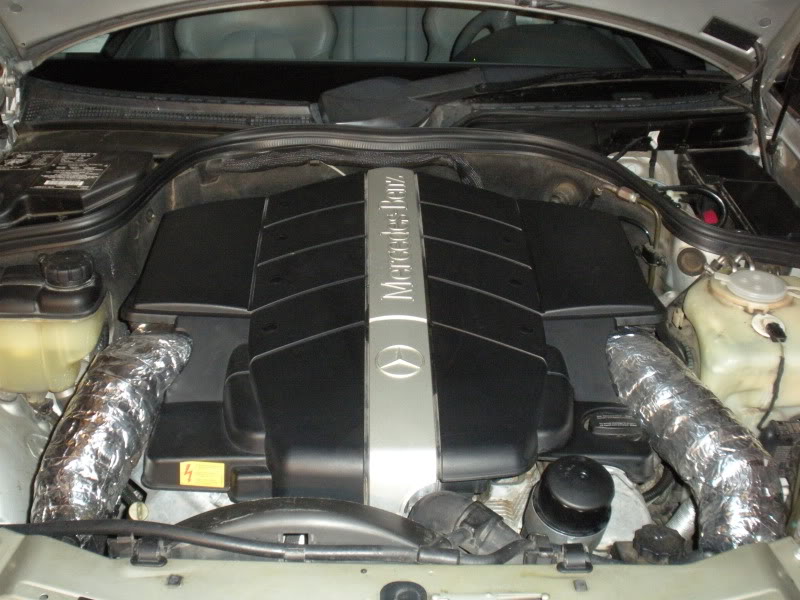
At this point, confident that I had eliminated all leaks, I recorded some temperatures to see how much improvement there was. With the vehicle at Idle:
Ambient Air Temp: 65° F
Intake Temp (IAT): 113° F
When I started driving around town, the temp stayed about the same, but when I got up to highway speeds the temperature dropped to 75 - 80° F. This was a drastic improvement over the 80° - 100° F above ambient, that I was getting before. I was happy with the readings I was getting at highway speed, but still wondered if I could further decrease the low speed/idle temp.
I took a piece of “Thermo-Tec Cool-IT Mat”, and trimmed it to make a heat shield to fit the cover that encloses the air filter. I also trimmed a piece to fit the triangular portion of the housing, which feeds pure air from the filters to the MAF. I reinstalled the Air Cleaner on the engine, brought the engine back up to operating temp, and was pleased to see the results. With vehicle at Idle:
Ambient Air Temp: 65° F
Intake Temp (IAT): 89.5° - 92° F
Same as before, driving around town the temp stayed about the same as it was at idle. However, at highway speeds, so far I'm getting temps 0° - 10° above ambient air temp, yet another improvement.
Still, after all that, I'm not convinced that it made much difference as far as performance. Like I said before, the air is still flowing through the intake manifold (which is as hot as 200° in some areas) and the ports. In retrospect, I would like to try putting a heat shield around the lower portion of the manifold itself, to block the heat that's radiated from the engine block, and see if that makes a difference in performance. However, having just removed and reinstalled the entire manifold, I have no desire to do it again anytime soon, and I'm not sure it can be done with the manifold on the car. Anyway, take it or leave it, but the air charge does appear to take on significant heat as it passes through the intake system. Whether it has any effect on the temperature of the air when it actually reaches the cylinder is for somebody else to determine.
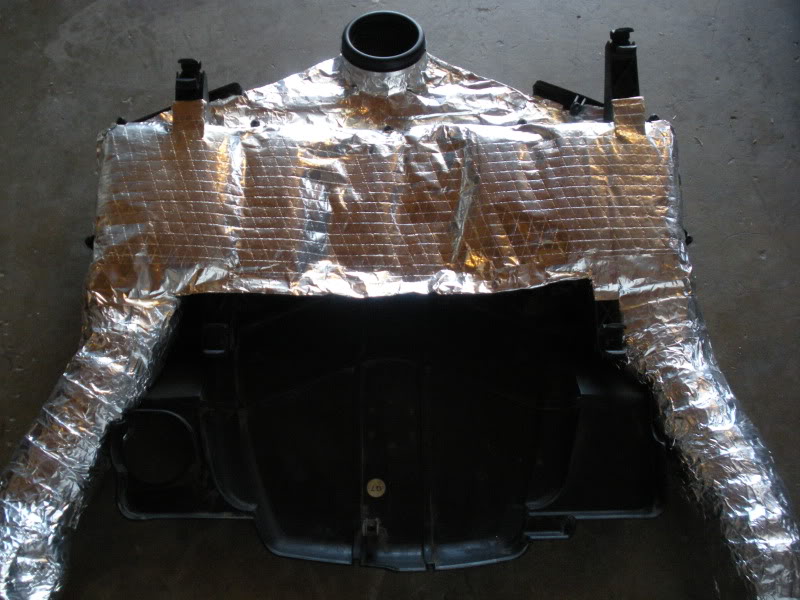
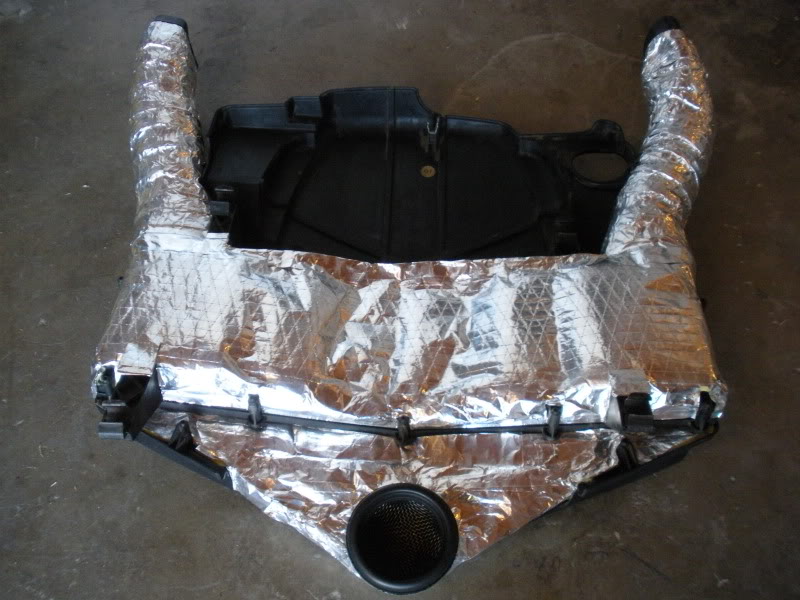
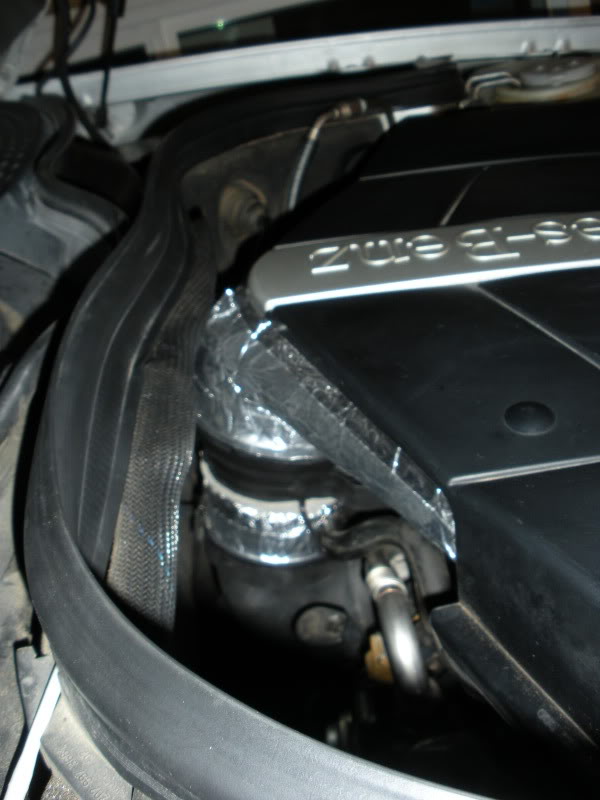
The Air Cleaner is designed to let air flow between the air filter housing and the top cover. Note that I was careful not to block this space with insulation.
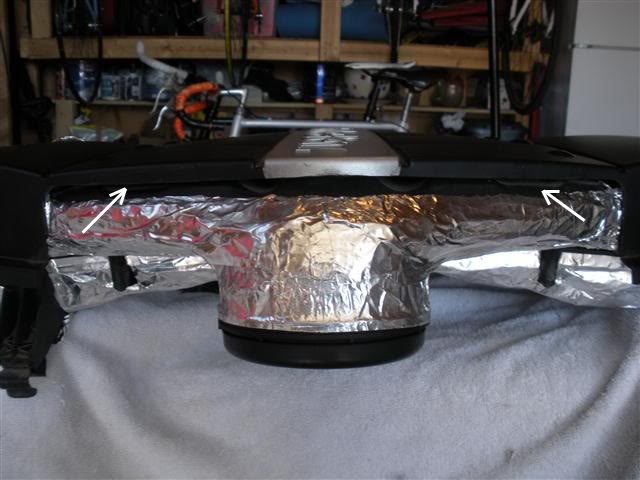
Initial Data:
By watching the IAT while driving, I have noticed that the single largest factor that effects the IAT is the vehicle speed, but there are other variables. To eliminate as many variables as possible, I decided to take all recordings with the vehicle idling in Park, at operating temperature. First, I recorded temperatures at several different locations on the engine to provide reference points with which to compare the air cleaner temps. I recorded these readings with an Infrared Thermometer, taking each temp several times and calculating the average.
Ambient Air Temp: 65° F
Coolant Temp: 199.5° F
Top Surface of Intake Manifold: 125.6° F
Intake Manifold at Cylinder Head Bolts: 183° F
Front of Intake Manifold, at the very bottom (where the vacuum line inserts): 194° F
MAF: 117.5° F
Cylinder Heads (measured around the spark plugs): 176° -194° F
Air Filter Cover (which sits directly above the manifold): 118.5° - 123° F
Flaws and Initial Improvements:
First of all, the hoses that connect the air cleaner to the air scoops next to the radiator were loose fitting on both ends. Also, one of the hoses had developed a hole on the bottom side. I'm not positive what caused this, although I would guess it was a combination of heat decaying the plastic, and the hose being flexed as the air cleaner has been removed and installed for service. The other thing that was a major contributor to the high temps, is that the seal between the air cleaner and the MAF needed replacement, as it had shrunk and become brittle, allowing hot air to sneak by.
I mentioned this in another recent write up that I did, but I want to mention it again because it is important, especially if you live in a similar climate. The hot, dry climate in the Southwest (USA) causes materials like rubber and plastic to rapidly decay. This causes parts like rubber seals to shrink, lose their elasticity, and become brittle. The second thing to note about the climate here is the sun. The humidity level here is very low, and we average around 310 days of sunshine per year where I live. The sun is very intense and the UV levels very high. This has two negative effects on cars.
The first, anything that is frequently exposed to direct sunlight (such as windshield wipers, tires, dashboards, and headlights), decays rapidly leaving the material faded, brittle, and often cracked because the material “shrinks” or contracts. The second thing, is that the direct sunlight heats things up far beyond the ambient air temperature. For example, right now the air temperature outside is about 56° F, but the temperature of the windshield reads at 136° F (recorded with IR Thermometer). It is fairly early in the day, so you can imagine how hot the windshield will be by late afternoon. This is relevant for two reasons. One, the hood and fenders will reach similar temperatures (depending on paint color), so you can imagine the impact this will have on under-the-hood temperatures. Second, the sun has the same effect on asphalt, exposing the vehicle to high levels of heat radiating from the road surface.
So, I replaced the gasket that seals the Air Cleaner to the MAF. Next, I firmly connected the two hoses to the Air Cleaner, and using High-temp Hose Repair Tape, sealed the joint between the two so that no hot air from under the hood could sneak into the intake at this location. Then I reinstalled the Air Cleaner on the engine. Now, as I mentioned before, the hoses had loose connections at both ends. With that end now firmly attached and sealed up, the connection at the Air Scoops were even worse. The tabs that are supposed to hold the hoses in place on the scoops are worn, and are not capable of doing their job. Because of the accordion design of the hose, without something to lock them in place they rest a little short, leaving a gap between the end of the hose and the scoop. There is not adequate working room to seal the joint with tape like I had done at the other end.
I had already been contemplating wrapping the hoses with intake wrap, and possibly insulating the air cleaner itself, to experiment and test the theory that the design causes heating of the air charge. At this point, I was thinking that some added rigidity would help keep the hoses properly in place, and thus sealed properly. I didn't expect insulating the hoses to have much effect on temperature though. I put a little tension on each hose, just enough to increase the length by ˝ an inch or so, so that the hoses would rest snug in the scoops. While a buddy held this tension, I wrapped the hoses with insulation. Once the insulation was wrapped around the full length of the hose, it provided enough rigidity to keep the extra length. I then reinstalled the air cleaner on the engine. The extra bit of length was perfect to keep the hoses tightly seated at both ends. It actually compresses the hose slightly, keeping constant pressure on the fittings. It's worth mentioning that at one point I put my finger in the air scoops, and felt around. Unlike the IR thermometer, my finger was unable to determine the temperature in degrees, but I can report that when I touched the portion adjacent to the radiator, it was hot enough to make me cuss. I imagine this contributes (a small amount) to the increased air temps.

At this point, confident that I had eliminated all leaks, I recorded some temperatures to see how much improvement there was. With the vehicle at Idle:
Ambient Air Temp: 65° F
Intake Temp (IAT): 113° F
When I started driving around town, the temp stayed about the same, but when I got up to highway speeds the temperature dropped to 75 - 80° F. This was a drastic improvement over the 80° - 100° F above ambient, that I was getting before. I was happy with the readings I was getting at highway speed, but still wondered if I could further decrease the low speed/idle temp.
I took a piece of “Thermo-Tec Cool-IT Mat”, and trimmed it to make a heat shield to fit the cover that encloses the air filter. I also trimmed a piece to fit the triangular portion of the housing, which feeds pure air from the filters to the MAF. I reinstalled the Air Cleaner on the engine, brought the engine back up to operating temp, and was pleased to see the results. With vehicle at Idle:
Ambient Air Temp: 65° F
Intake Temp (IAT): 89.5° - 92° F
Same as before, driving around town the temp stayed about the same as it was at idle. However, at highway speeds, so far I'm getting temps 0° - 10° above ambient air temp, yet another improvement.
Still, after all that, I'm not convinced that it made much difference as far as performance. Like I said before, the air is still flowing through the intake manifold (which is as hot as 200° in some areas) and the ports. In retrospect, I would like to try putting a heat shield around the lower portion of the manifold itself, to block the heat that's radiated from the engine block, and see if that makes a difference in performance. However, having just removed and reinstalled the entire manifold, I have no desire to do it again anytime soon, and I'm not sure it can be done with the manifold on the car. Anyway, take it or leave it, but the air charge does appear to take on significant heat as it passes through the intake system. Whether it has any effect on the temperature of the air when it actually reaches the cylinder is for somebody else to determine.



The Air Cleaner is designed to let air flow between the air filter housing and the top cover. Note that I was careful not to block this space with insulation.

Thread
Thread Starter
Forum
Replies
Last Post
builderdude
General Tech
1
09-16-2010 11:17 AM



